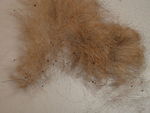Difference between revisions of "Flea Habitat and Control"
Jump to navigation
Jump to search
| (10 intermediate revisions by 2 users not shown) | |||
| Line 1: | Line 1: | ||
| − | {{ | + | {{unfinished}} |
| + | |||
==Habitats== | ==Habitats== | ||
| − | Although adult fleas are obligate blood feeders only 5% of the flea population will be on an animal at any one time | + | Although adult fleas are obligate blood feeders only 5% of the flea population will be on an animal at any one time. |
| − | + | *Only approximately '''5%''' of the flea population will be on the animal at any one time (and usually it is a much smaller percentage) | |
| − | |||
| − | |||
| − | |||
| − | + | *The rest of the population are in the '''environment''' | |
| + | **E.g. Eggs, larvae, pupae and unfed adults | ||
| − | + | *Fleas accumulate in certain '''hot spots''' where the animal spends the majority of its time | |
| + | **E.g. Warm, shady, humid ares | ||
| + | **E.g. Outdoors in warmer climates or inside in temperate climates | ||
| − | + | *Very large numbers of eggs are found in areas where cats land after jumping as they have been dislodged | |
| + | **E.g. Beside sofas | ||
| + | ==Control== | ||
| + | [[Image:Flea Dirt.jpg|thumb|right|150px|''Flea Dirt'' <p> DrZak 2006, Wikimedia Commons]] | ||
| + | [[Image:Flea Bites.jpg|thumb|right|150px|''Flea bites on a human'' NZfooty 2007, Wikimedia Commons]] | ||
| + | *Single or occasional treatments will only give temporary relief from fleas as the majority of the population is '''in the environment''' | ||
| − | + | *Appropriate action must be taken to stop re-infestation | |
| − | |||
| − | |||
| − | |||
| − | |||
| − | |||
| − | |||
| − | |||
| − | + | *The animal must be rid of its resident flea population | |
| + | *The animal should be protected against subsequent re-infestation | ||
| + | **From within the home | ||
| + | **From outside the home | ||
| − | + | *The environmental reservoir population should be eliminated | |
| + | **Animal treatment to deplete reservoir | ||
| + | ***Adulticides | ||
| + | ***Adulticides with larvicidal effects | ||
| + | ***Insect growth regulators (IGR's) | ||
| + | **Direct chemical treatment of domestic environment | ||
| + | ***Insecticides | ||
| + | ***Insect growth regulators | ||
| + | ***Inorganic chemicals | ||
| + | ***Entomophagous nematodes (These are parasitic nematodes which predate other parasite eggs) | ||
| − | + | *To prevent resistance occurring, control methods should not rely solely on chemical methods | |
| + | **Hygiene such as regular vacuuming and washing of the animal's bedding should also occur for the most effective treatment | ||
| − | [[Category:Fleas | + | *For more information on the chemicals used for flea treatment click |
| − | [[Category: | + | [[Ectoparasiticides|here]] |
| + | [[Category:Fleas]] | ||
| + | [[Category:To_Do_-_Parasites]] | ||
| + | [[Category:To_Do_-_NickJ]] | ||
Revision as of 16:57, 25 July 2010
| This article is still under construction. |
Habitats
Although adult fleas are obligate blood feeders only 5% of the flea population will be on an animal at any one time.
- Only approximately 5% of the flea population will be on the animal at any one time (and usually it is a much smaller percentage)
- The rest of the population are in the environment
- E.g. Eggs, larvae, pupae and unfed adults
- Fleas accumulate in certain hot spots where the animal spends the majority of its time
- E.g. Warm, shady, humid ares
- E.g. Outdoors in warmer climates or inside in temperate climates
- Very large numbers of eggs are found in areas where cats land after jumping as they have been dislodged
- E.g. Beside sofas
Control
- Single or occasional treatments will only give temporary relief from fleas as the majority of the population is in the environment
- Appropriate action must be taken to stop re-infestation
- The animal must be rid of its resident flea population
- The animal should be protected against subsequent re-infestation
- From within the home
- From outside the home
- The environmental reservoir population should be eliminated
- Animal treatment to deplete reservoir
- Adulticides
- Adulticides with larvicidal effects
- Insect growth regulators (IGR's)
- Direct chemical treatment of domestic environment
- Insecticides
- Insect growth regulators
- Inorganic chemicals
- Entomophagous nematodes (These are parasitic nematodes which predate other parasite eggs)
- Animal treatment to deplete reservoir
- To prevent resistance occurring, control methods should not rely solely on chemical methods
- Hygiene such as regular vacuuming and washing of the animal's bedding should also occur for the most effective treatment
- For more information on the chemicals used for flea treatment click

